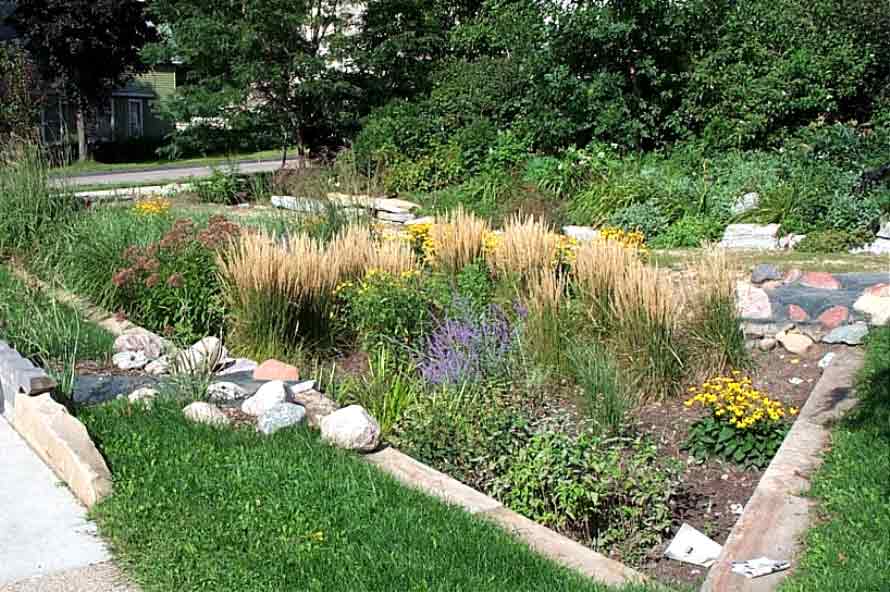| 1. Rain Gardens | 2. Sand Filters
Rain Gardens
 |
| Rain Garden |
What is a Rain Garden?
A Rain Garden or "bioretention basin" is a vegetated depression in an urban landscape that collects, treats, and recharges storm water into the ground. Because it is a garden as much as it is a treatment area, the basin is usually cultivated with native, ornamental plant species
Some people distinguish a difference between a "rain garden" and a "biorentention basin." This difference is that biorentention basins usually have some sort of engineered overflow structure such as a weir or drainpipe. Under this school of thought, rain gardens are just gardens that store and infiltrate water. In this article, however, the two are treated synonymously.
Why use Rain Gardens?
Rain gardens are an excellent way to gather the stormwater that lands on the impervious surfaces of smaller properties. This is an example of Low impact Development that is primarily designed for stormwater infiltration, and water quality treatment is more of a secondary benefit. Bioretention basins are most effective if they are installed at places where they can easily gather stormwater from an impervious surface, such as at the outlet of a rooftop gutter or in"landscape islands". Because the ratio of treatment area to drainage area is relatively high (about 10%), it is recommended that rain gardens treat areas less than 5 acres.
How do they manage stormwater?
Bioretention basins are depressions in the landscape that collect rain water that lands on impervious surfaces and trickles downhill into the basin. The water enters the rain garden either by direct inflow (if the garden is adjacent to the treatment area), or by traveling through a grass channel. The grass channel (1) reduces stormwater velocity because the roughness of the channel increases the friction and (2) filters total suspended sediments.
During the rain event, that collected runoff pools to a design depth in the basin. Eventually, the water seeps down into the first soil layer that is made of mulch to provide organic materials to the plants living in the garden. While the water seeps through the mulch layer, some of it is absorbed by the plants and then returned to the atmosphere through evapotranspiration.
Beneath the mulch, there are two soil layers engineered to have high porosity. The extra voids in the soil store water below the surface and allow it to seep into the ground quickly. Also, microbial organisms that digest the chemical pollutants and improve water quality live in this mulch layer. The upper layer is usually made of sand, the lower made of gravel. The infiltration provided by these two soil layers reduces the amount of stormwater that reaches the sewer system because it instead recharges it into the ground. Also, the water enters streams and rivers underground, as base flow. This is preferred to entering as surface runoff because large runoff volumes can cause channel erosion and increase pollution concentrations.
Are there any other benefits to having Rain Gardens?
Rain gardens provide the same aesthetic and ecological benefits to an urban area that traditional gardens do. Not only does the vegetation improve the visual appearance of a parking lot or street side right of way, but it also increases available habitat for wildlife. If trees and herbaceous plants are included in the design, then the more diversified habitat allows for more diversified species.
Since rain gardens accumulate biomass, they sequester carbon dioxide from the atmosphere which can minutely offset the effects of greenhouses gases. The basins also can lower the temperature locally by reducing the urban heat island effect. This is done by the leaves directly shading out sunlight and by the water from the pond surface absorbing some of the heat during evaporation.
Are there any constraints / design considerations?
There are many considerations when designing a rain garden. The first is, what design storm event is going to be used and what is the drainage area. These considerations would affect the geometric dimensions of the garden including surface area and the depth of the collected water. Also, the rain garden should have some measures to prevent flooding. This could be a weir that allows water of a certain depth to overflow into another channel leading to a traditional storm water drain. An alternative is a stormwater drain within the garden that when the water reaches a certain depth, it enters the drain directly from the garden.
Also, underdrains expedite the removal of water from the rain garden. They are are perforated PVC pipes within the gravel layer that transport treated water away from the garden area to a storm sewer. Also, vertical groundwater wells can be used to bring the water deeper into the water table.
Selecting the appropriate plants is an important factor in designing a bioretention basin. Native plants are preferred, because they can survive the local climate. Also, the species should be tolerant of high moisture levels, and therefore able to survive the periodic ponding that occurs. A mix of grasses, reeds, herbaceous and trees species will allow a variety of wildlife species to inhabit that garden. Since this is a garden, the ornamental quality of the plants should be considered during selection.
Some constraints of the rain garden are that the treatment area is limited, and they provide no real protection from major flood events. Also, since rain gardens are often installed in parking lot landscape islands or along road sides, they limit the space available for automobiles.





